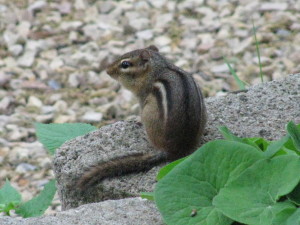Wildlife sometime create yard mischief. Raccoons, possums, and skunks tip over trash cans in the middle of the night. Chipmunks tunnel under walls, moles heap mounds of dirt. And woodchucks and cottontails raid the garden.
Damage, or perceived damage, often infuriates homeowners. Woodchucks have the uncanny ability to harvest lettuce the day before it is to be picked for an evening salad, and raccoons raid the sweet corn patch the moment ears are ripe. Moles hump up hills of dirt that lawnmowers hit, and skunks mine into the sod for grubs. What’s a homeowner to do?
WHY WILDLIFE CAUSE PROBLEMS
There’s no mystery to it. Wild animals are attracted to yards because they are comfortable places to live or find food. All living creatures need food, shelter and water to live. Yards frequently offer these basic needs all in proximity. Create a beautiful diverse yard and wildlife will enjoy it as much as people. In most cases people love seeing most species of wildlife in their yards, but often agree that they are best enjoyed in moderation.
THREE STEPS TO CONTROL GARDEN WILDLIFE DAMAGE
There are three ways to effectively overcome, or at least minimize, wildlife damage.
Homeowners differ in their strategy on how they weigh the benefits versus problems of wildlife in the yard.
Strategy One: Tolerate damage and enjoy wildlife.
It’s a state of mind that may require attitude adjustment. How important is a perfect lawn or head of cabbage, versus watching a cottontail mom peacefully nurse her babies on the edge of the law? How valuable is the beauty and inspiration gained from seeing chipmunks pack their cheeks with seeds and scamper across the yard versus the tunnels they make in retaining walls? For many people having beautiful and interesting wildlife out the window far outweighs damage they may cause.
We had a friend who grew a tiny garden with a few lettuce plants, a short row of string beans, and one hill of summer squash. When a cottontail devoured them she was incensed and declared war on bunnies. She bought traps but never managed to catch them. She built a fence but the lettuce thieves found their way under it. Her stress level rose as plants disappeared.
We suggested she might rely on simple arithmetic to solve her problem.
“Instead of spending about a hundred bucks on fencing and traps, wouldn’t it be simpler and cheaper to just buy lettuce, squash, and beans at the farmer’s market”, we asked her. She agreed. It took some mental adjustment, but now she buys locally grown vegetables and enjoys watching the cottontails that she once hated.
SOMETIMES IT’S BEST TO JUST IGNORE MINOR DAMAGE AND ENJOY WILDLIFE.
Strategy two. Preventing damage in the first place.
The saying, “An ounce of prevention is worth a pound of cure,” holds true for wildlife damage. In most cases homeowners can both enjoy wildlife and prevent or greatly reduce damage critters might do. Some simple ways to anticipate and reduce conflict include:
Fencing: Craft fences sturdy enough to keep rabbits and woodchucks out of the garden. Cottontails, for example can jump a long ways horizontally but not high vertically. An inexpensive 18 “ tall temporary fence of chicken wire will keep them out of the garden. Woodchucks are more challenging, as they are expert diggers and climbers. A garden fence needs to extend below the ground to keep them out and needs to be at least three or four feet tall. Watch for more fencing specifics in future editions of Winding Pathways website.
Securing: Store trash cans inside the garage with the door closed to keep raccoons from tipping it over. Better yet, compost food scraps and don’t put anything in the can that will interest wildlife. Composting turns waste into a wonderful resource that improves the soil. Don’t let the trash man cart it away. Some people who prefer not to add meat scraps to the compost bin, feed them to a small flock of chickens or simply put them on the edge of the yard in the evening for the raccoons to devour. No more tipping over the trash can.
PREVENTION IS A KEY
Strategy three: Killing the offending animal.
Often people resort first to killing an animal. However killing a few woodchucks, raccoons, moles, or chipmunks will not solve damage problems. These animals are in the yard because they find perfect conditions there to live. Remove a few and others will move in. Keep killing and you’ve created a wildlife death trap.
Sometimes it is necessary to kill an animal. Upcoming issues of Winding Pathways will feature tips on how to eliminate problem animals.


